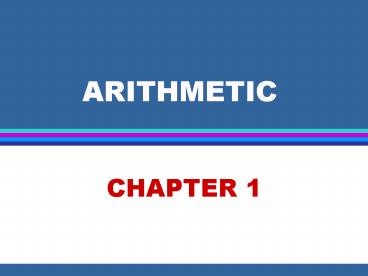ARITHMETIC - PowerPoint PPT Presentation
Title:
ARITHMETIC
Description:
ARITHMETIC CHAPTER 1 ARITHMETIC 1.1 Rational Numbers Rational Numbers 1.2 Exponent; Base; Decimal 1.3 Estimation & Operations 1.3 Estimation & Operations 1.4 ... – PowerPoint PPT presentation
Number of Views:211
Avg rating:3.0/5.0
Title: ARITHMETIC
1
ARITHMETIC
- CHAPTER 1
2
ARITHMETIC
1.1 Operations with Rational Numbers 1.2
Exponents, Base Decimals 1.3 Estimation
Decimal Operations 1.4 Equivalence, Order
Sequences 1.5 Percents 1.6 Word Problems
3
1.1 Rational Numbers
Types of Numbers natural, whole, integers,
rational, prime, composite, fractions, mixed
Addition Sign Rules If same signs, add keep
the sign. If different signs, subtract smaller
from larger and give sign of the larger.
4
Rational Numbers
Addition continued
Change mixed numbers to fractions. Find Least
Common Denominators
5
1.1 Adding Subtracting
1.
Remember to find common denominators first.
Did you forget the 2
6
1.1 Adding Subtracting
3.
It is subtraction! Subtract smaller from larger
and give same sign as larger. (Thus result is
negative)
We need to get 4/4 from 2 2 1 and 4/4
7
1.1 Adding Subtracting
4.
First let us change the -(-1) to a 1
Remember bigger minus smaller, sign bigger!
(result must be positive)
8
1.1 Multiplying Dividing
Multiplication Division Rules of Signed Numbers
If same signs, result is positive.
If different signs, result is
negative.
Multiplication of Fractions
Division of Fractions
9
1.1 Multiplication Division
2
5.
1
10
1.1 Multiplication Division
7.
Same signs means positive result!!
Remember to invert the second fraction!
11
1.2 Exponent Base Decimal
A. Definition of Exponents
B. Place Value Base
Place value increases moving left of units place,
and decreases moving right of units place.
12
1.2 Examples
1.
13
1.2 Examples
5. Select the place value associated with the
underlined digit 83,584.02
14
1.3 Estimation Operations
A. Estimating Sums, Averages or Products An
estimate of the average is between the highest
and lowest.
15
1.3 Estimation Operations
B. Operations with Decimals To add or
subtract line up dec. pts. To multiply number
of dec. places in the product is the sum of the
number of dec. places in the factors. To divide
if divisor is whole number, bring decimal pt. up.
If divisor is not, move decimal point as needed.
16
1.3 Estimation Examples
1. If a unit of water costs 1.82 and 40.435
units were used, which is a reasonable estimate?
(Water is sold)
A. 80,000 B. 800 C. 8000 D.80
17
1.3 Estimation Examples
4. 500 students took an algebra test. All
scored less than 92 but more than 63. Which of
the following could be a reasonable estimate of
the avg. score?
A. 96 B. 63 C. 71 D. 60
18
1.3 Decimal Examples
7. 14.22 - 1.761
It is smaller than 14.22 - 1.2213
A.12.459
B.13.459
It is larger than 14.22 -212.22
C.11.459
D.12.261
19
1.3 Decimal Examples
10. 3.43 x 2.8
A. 0.9604
Estimate 3 x 3 9
B. 8.504
Larger than 3 x 2.8 8.24
C. 7.1344
D. 9.604
20
1.3 Decimal Examples
735
12.
A. 735
Dividing by a number between 0 and 1 will cause
the result to be larger than original number
B. 73.5
C. 7.35
D. 0.0735
21
1.4 Equivalence Order Seq.
Rational numbers can be written as fractions,
mixed numbers, dec. or
To compare two rational numbers, express them in
the same way
A sequence of numbers is arranged according to
some law. Look for the pattern to find the next
number.
22
1.4 Equivalence Examples
1. 0.19
0.19 is not greater than 1
means divided by 100 19/100 0.19/1000.0019
23
1.4 Equivalence Examples
2. 350
A. 0.350
B. 3.50
C. 350.0
D. 3500
24
1.4 Equivalence Examples
3.
A. 0.92
B. 0.092
C. 9.2
D. 0.92
25
1.4 Order Examples
100
260
A.
5.
B. lt
sm
lg
lt
C. gt
lt
8.
sm
lg
A.
B. lt
C. gt
26
1.4 Sequence Examples
10. Identify the missing term in the following
geometric progression
PATTERN
Multiply each denom. by 4 to get the next
Signs alternate
Thus, positive
256 x 4 1024
27
1.5 Percents
Percent increase or decrease
Percent problems
Real-world problems with percent
R S T U V
Method
28
1.5 Percent Examples
1. If 30 is decreased to 6, decrease?
4
5
p 80
5p 400
A. 8 B. 24 C. 20 D. 80
29
1.5 Percent Examples
5. What is 120 of 30?
10x 360
x 36
A. 0.25 B. 25 C. 36 D. 3.6
30
1.6 Word Problems
- A car rents for 180 per
week plus 0.25 per mile.
Find the cost of renting this
car for a two week trip of 400
miles for a family of 4.
D. 760
B. 380
A. 280
C. 460
31
1.6 Word Problems
6. Find the smallest positive
multiple of 6 which leaves a
remainder of 6 when divided
by 10 and a remainder of 8
when divided by 14.
B. 18
A. 36
D. 53
C. 48
32
REMEMBER
MATH IS FUN AND
YOU CAN DO IT































